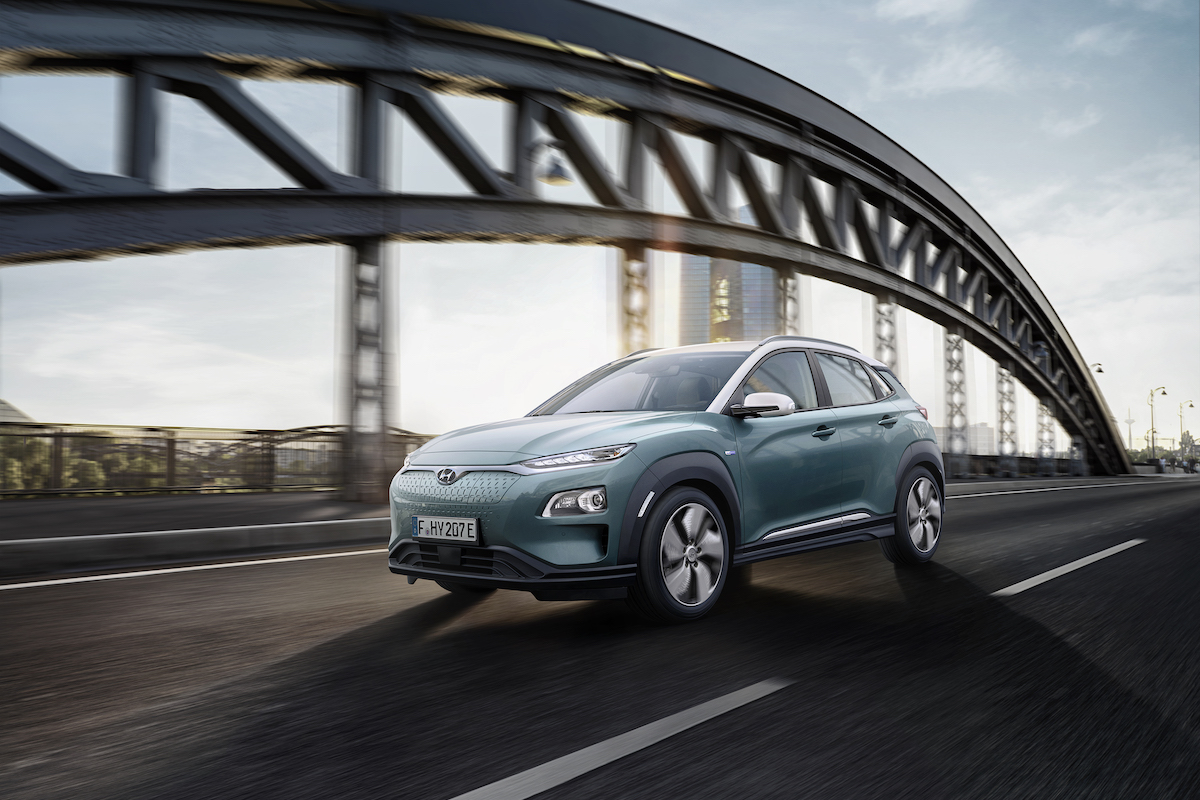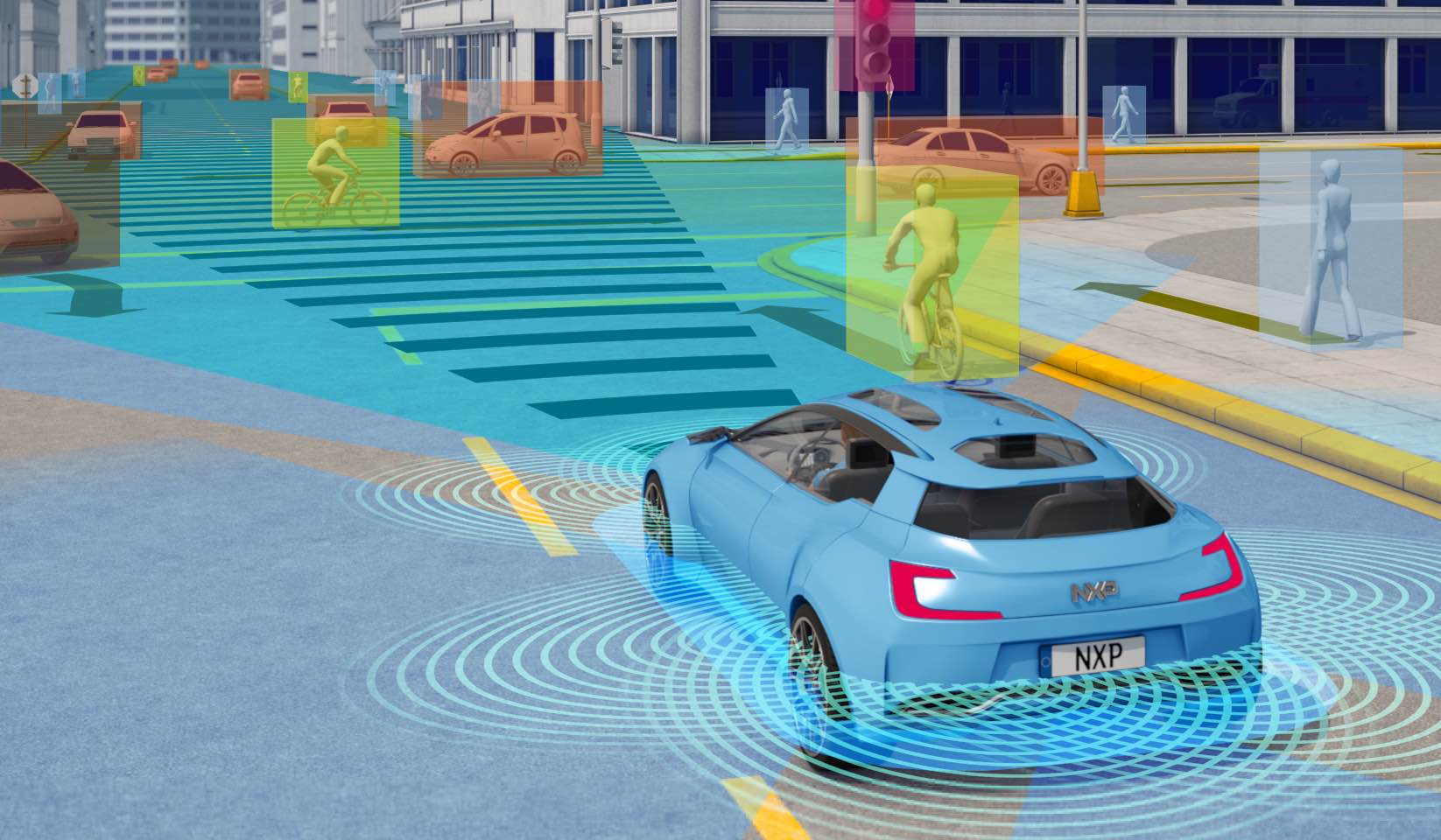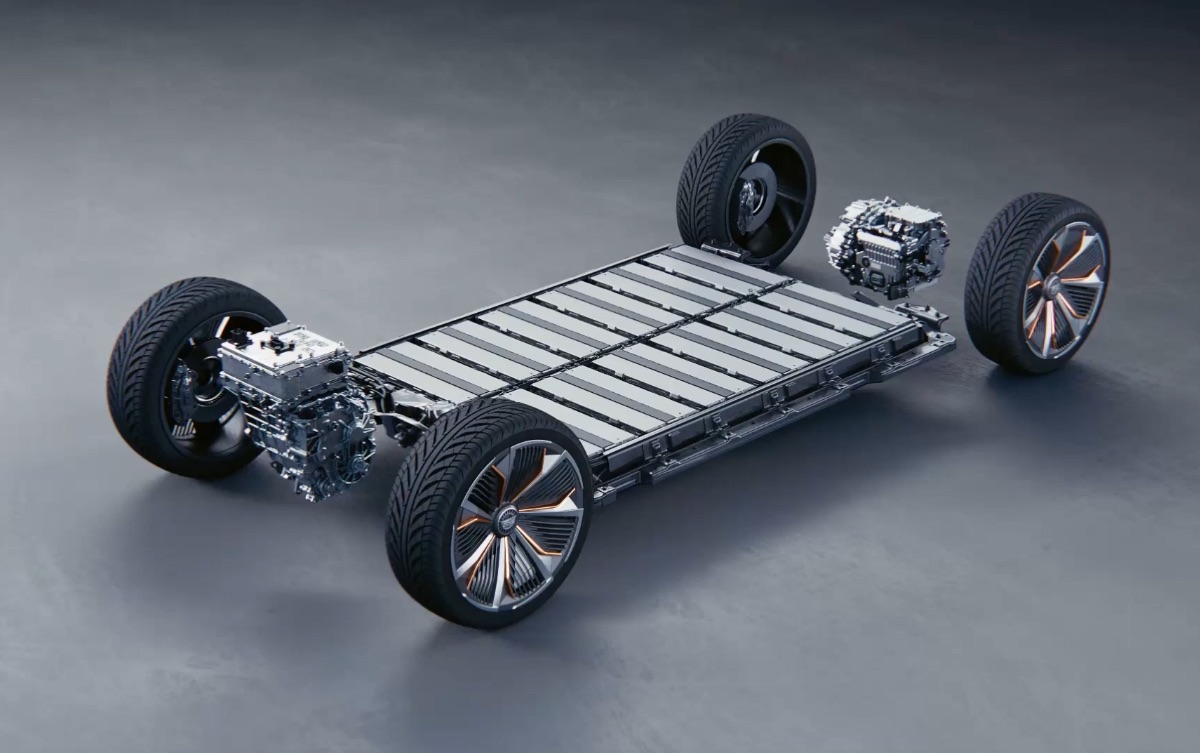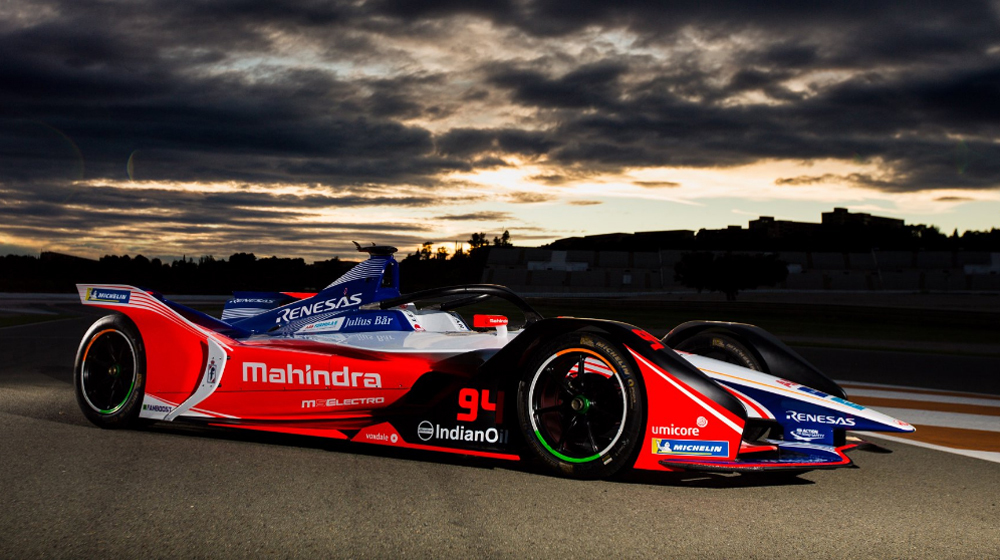It’s a well-known fact that Norway is a global leader in electric vehicle adoption with over 50% of all registered cars powered by some type of electric technology. So how did a relatively small, oil-rich country in northern Europe manage to accomplish such large EV adoption?
The secret or rather secrets of Norway’s successful vehicle adoption policy are numerous, but they mainly converge around a package of government-imposed incentives gradually introduced during the last three decades.
Aside from incentives, the Norwegian government is also implementing stiff taxation on all internal combustion engine-powered (ICE) vehicles. Extremely high progressive import and registration taxes which can amount to more than 100% of the vehicle’s initial value are a clear discouraging factor for any conventional ICE vehicle buyer.
Norwegian EV Policy Overview
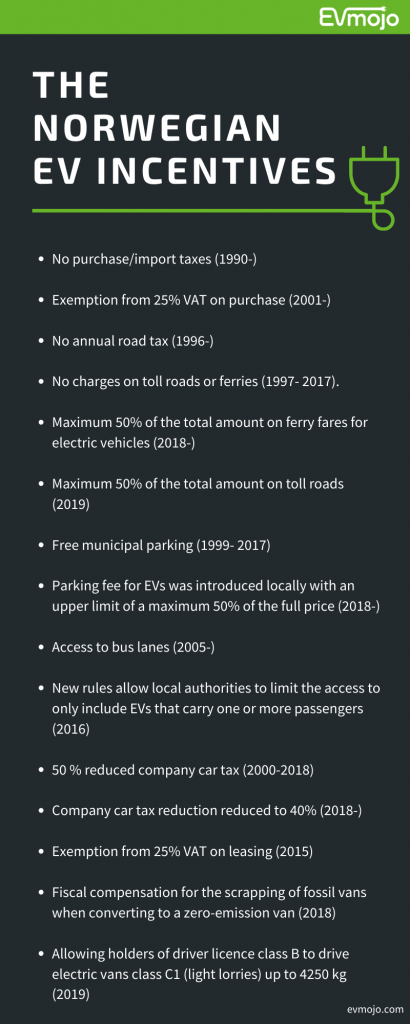
It’s no secret that a country which has achieved 75% market share EVs in 2020 has a wide array of favourable incentives. Some of Norway’s policies on electric cars are more palpable like the mentioned exemption from import tax or exemption from 25% value-added tax upon purchase.
Other policies might not be as substantial but can still make a world of difference for an average Norwegian car owner. Access to bus lanes, exemption from annual road tax, free public parking, and no charges on toll roads are only some of them.
It has to be noted, however, that municipal parking, road tolls, and ferry charges are gradually being reintroduced, but electric vehicle owners will be paying at most 50 per cent of what conventional ICE vehicle owners are paying.
These progressive policies and favourable subsidies are part of the reason why Norway leads in electric cars. However, that’s only the tip of the iceberg considering the magnitude of the zero-emissions vehicle (ZEV) phenomenon that’s rooted itself in this Scandinavian country.
It’s cheaper to buy the electric version
According to Lasse Fridstrøm of the Norwegian Centre for Transport Research – Institute of Transport Economics,
“the Norwegian policy recipe consists in stiff taxation rather than in generous subsidization. It can be replicated by any country, rich or poor”
Lasse Fridstrøm
In other words, most Norwegians are practically forced to switch to ZEVs in order to actually save money in the long run. Not only that, but an average EV version of a car model can cost less than its conventional ICE counterpart after all VAT, import, and registration tax reductions and rebates.
An example of these economics are presented below for a VW Golf, even though the EV version is over 11,000 Euro more expensive to import, it ends up costing almost 1,000 Euro less after incentives.
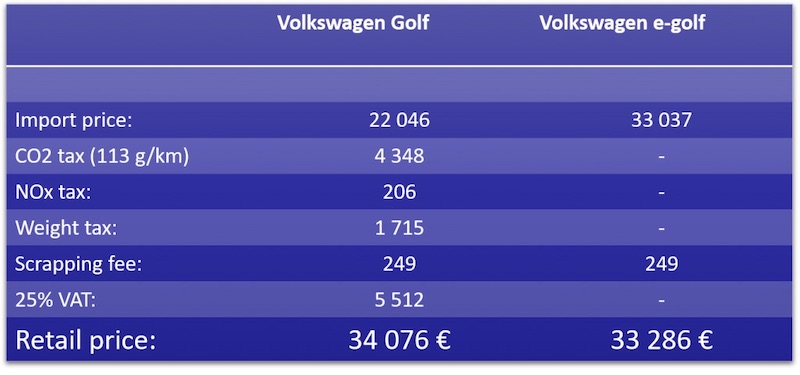
Norwegian EV Market Share
The EV market share in Norway has been exhibiting consistent growth, year in, year out. From only around 15% market share in 2015 to a record hitting 75% in March 2020, the recent growth has practically been exponential.
Of that, 75.2% consisted of Battery Electric Vehicles (BEVs) & Plug-In Hybrid-Vehicles (PHEV’s), (up from 44.8% in 2018), hybrids made up 7.1% and traditional fossil-fueled vehicles were only able to hold a 17.7% market share.
It is important to note, however, that this sales data is from March 2020 and since then, market forces such as COVID-19 have negatively affected sales volumes, however, it is fair to say that pre-COVID the trend was definitely on a consistent upward trajectory.
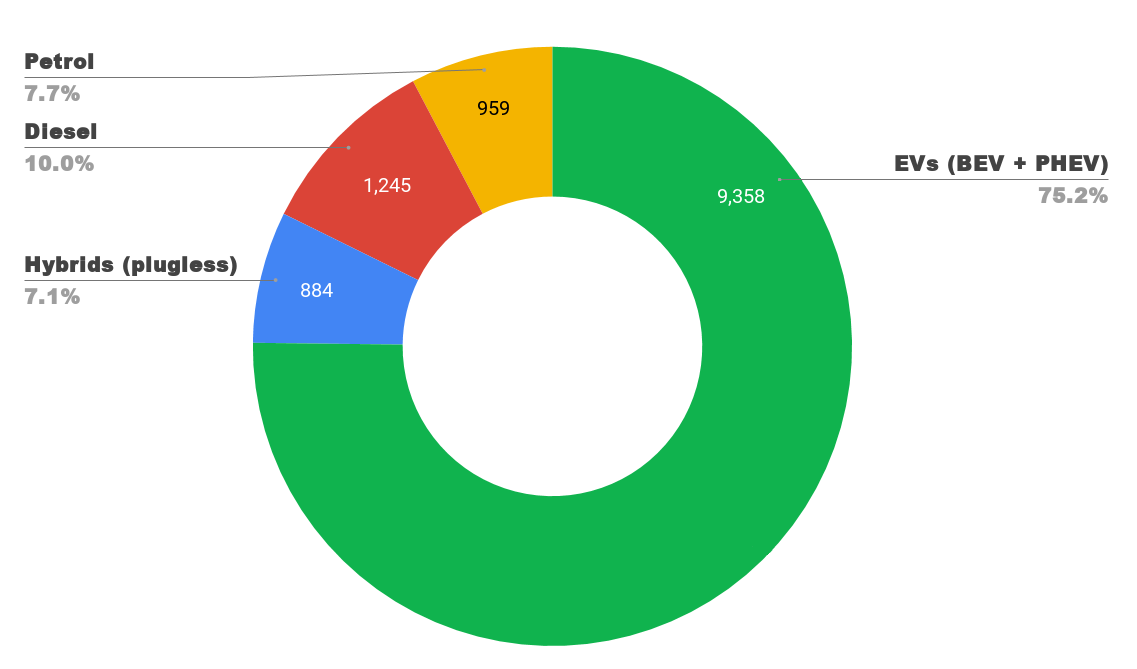
What is Norway’s best selling Zero Emissions Vehicle?
The best-selling ZEV in Norway has, unsurprisingly, been the Tesla Model 3. Upon its inception into the market in 2019, the most affordable Tesla to date has become the undisputed king of Norwegian roads. As many as 15,683 Tesla Model 3’s were delivered throughout Norway in 2019 alone, which makes up to an imposing market share of 11%. In other words, one in every nine Norwegian new car owners in 2019 had ordered the Model 3.

So why does Norway have so many Teslas?
Although there’s no genuine explanation as to why the Norwegians are in love with Teslas, the fact that they’re “greener” and much more affordable than comparable luxury cars has certainly played an important role.
We also must not forget the fact that, for a while, Tesla was the only viable option for buyers in need of a long-range EV with fast charging capability.
This has changed in recent years as traditional automakers are now more focused on the EV segment but Norwegian people’s love for Tesla remains tenacious.
Combined with all the other incentives that come along with owning an electric car in Norway, it’s no wonder why the people there have chosen to put their faith in a company committed to an emission-free future – just like Norway and Norwegians themselves are.
| Rank | Manufacturer | Volume | Share |
|---|---|---|---|
| 1 | Tesla | 3,760 | 24.5% |
| 2 | Volkswagen | 1,825 | 11.9% |
| 3 | Toyota | 1,750 | 11.4% |
| 4 | BMW | 801 | 5.2% |
| 5 | Audi | 733 | 4.8% |
| 6 | Volvo | 653 | 4.3% |
| 7 | Hyundai | 643 | 4.2% |
| 8 | Skoda | 635 | 4.1% |
| 9 | Mitsubishi | 579 | 3.8% |
| 10 | Nissan | 569 | 3.7% |
Norwegian Charging Network and Energy Consumption
Apart from providing a myriad of ZEV-related amenities, Norway also boasts a well-organized charging infrastructure consisting of around 15,000 publicly available charging points; over 1,500 of which support fast charging.
For comparison, the United States – which is around 30 times larger than Norway in terms of size and boasts 60 times larger population – makes do with “only” a little over 20,000 charging stations with close to 69,000 connectors; under 11,000 of which are DC fast chargers. What’s more, around one-third of the total charging connectors can be found in California.
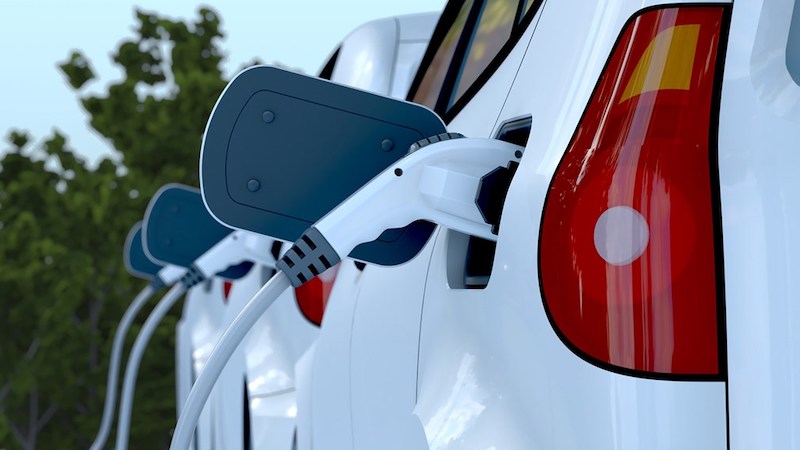
Australia’s EV charging network
Australia fares much worse in that regard. A country that’s geographically almost 25 times larger than Norway and boasts around five times Norway’s population, has to make do with a comparably low figure of EV charging stations.
According to the latest information from the Electric Vehicle Council, there are currently less than 2,000 public charging stations across Australia, with only 250 of them supporting fast charging. Judging by this data, it’s easy to see where one of the biggest opportunities for implementing a successful EV adoption strategy lies for Australia.
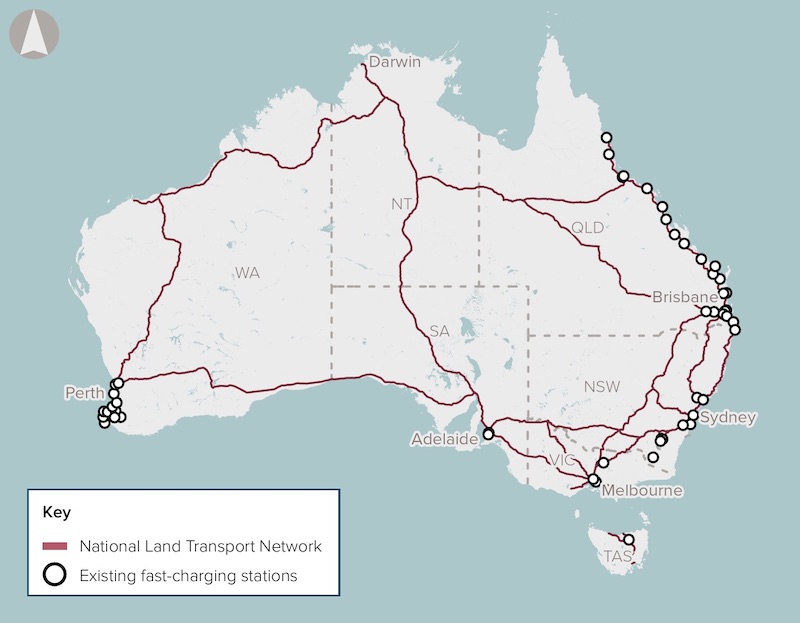
Can other countries copy Norway’s playbook?
It’s also worth noting that policy experts Marie Aarestrup Aasness and James Odeck of Norwegian University of Science and Technology in Trondheim, firmly believe that other countries shouldn’t blindly follow in Norway’s footsteps without considering all of the adverse effects first.
According to their research, Norway is losing on a significant amount of revenue due to EV users’ exemption from road tolls and parking fees (although these are gradually being reintroduced on a local level, to some extent). Furthermore, allowing EV users access to transit lanes has unintentionally led to their congestion, inadvertently translating to increased travel times for public transport users.
Norway is less dependent on fossil fuels
While Norway has enjoyed a considerable decrease in greenhouse gas emissions, this doesn’t necessarily have to be the case with other countries. Norway mainly relies on renewable energy in the form of hydropower.
Meanwhile, the USA which mainly relies on fossil fuel and nuclear energy (almost 63% and 20% respectively), and only produces 17.5% of electricity through renewable sources, can’t expect the same results in greenhouse gas reduction.
Australia isn’t faring any better in that regard. Although it is one of the wealthiest countries in the world by GDP per capita, it is still heavily dependent on coal, with around 60% of its electricity coming from this particular fossil source. This clearly tells us that the Norwegian success story in electric vehicle adoption is somewhat unique and hardly applicable by other countries – at least in terms of greenhouse gas emissions reduction.
Electric cars consume less energy
There’s another interesting “by-product” of current and future Norwegian EV policies. According to Mr Fridstrom, the total energy consumption on Norwegian roads for the period between 2018 and 2030 is due to shrink by between 15 and 26 per cent in spite of 15 per cent traffic growth. This is simply due to the fact that the electric motor is three to four times more efficient than the conventional internal combustion engine.
The following chart is a 2050 projection of the energy consumption of road transportation in Norway.

Projection Models in Norway
The Norwegian Government has decided to put forth a bold plan regarding future vehicle structure. All passenger cars and light vans sold by 2025 should be zero-emission – either battery-electric or hydrogen-powered – while all city busses should either be ZEVs or use biogas.
At the same time, all new heavy vans, 75% of new long-distance buses, and 50% of new trucks should be zero-emission by 2030. This bold but feasible plan is expected to be imposed on by providing further green tax incentives, rather than imposing additional ICE bans.
Is Norway’s EV growth sustainable?
But just how feasible is this plan? Different case studies have yielded different results, but most of them agree that accelerating electric vehicle adoption at this rate will be hard to accomplish. Mr Fridstrom, for instance, argues that Norway will reach between 74.3 per cent and 99.3 per cent of BEV market share by 2030 for all-new passenger cars sold.
The following chart is a 2050 projection of EV market share in Norway
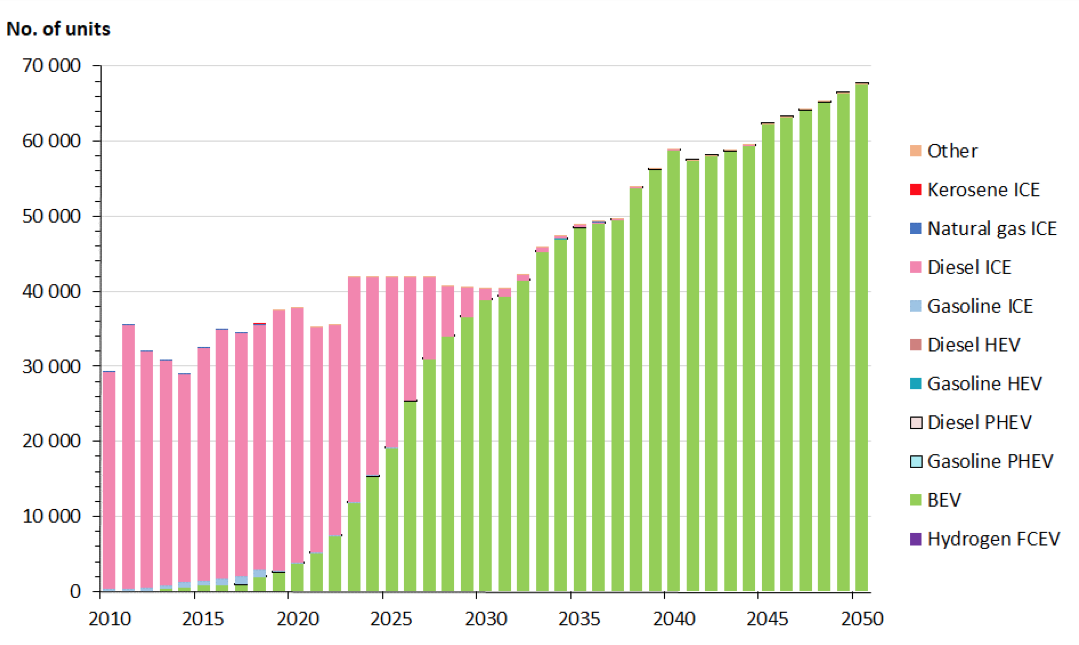
In a research conducted for the European Commission, Joint Research Centre in Ispra, Italy, Sebastiaan Deuten, Jonatan J. Gómez Vilchez, and Christian Thiel came to some interesting conclusions. Using several different scenarios, they’ve established projections for 2030 and 2050 alike. According to them – in the best-case scenario – the Norwegian ZEV market share will reach as high as 58.8 per cent by 2030, and as much as 96.3 per cent by 2050.
An Example of Oslo’s EV Success Story
Oslo isn’t just Norway’s capital and largest city, but the EV capital of the world in terms of deployed electric vehicles per capita. Even back in 2017 more than 50% of all-new cars bought in Oslo were either EVs (37.5%) or plug-in hybrids (14.1%). This percentage has been on the rise ever since, as Norwegians are still flocking to make use of countless EV-related amenities at their disposal.
Growing pains – Charge station queues
Such exponential growth of electric vehicles on Oslo’s streets has presented its challenges. One of those challenges has been trying to match the pace of charger deployments with the pace of new EV’s hitting the roads. There have been numerous complaints by EV owners in recent years that the lack of charges has led to queues with long wait times.
In order to remedy the issue, the Oslo city council, in close cooperation with various private companies, decided to triple the deployment of new charging stations. Private companies willing to contribute to Oslo’s charging infrastructure are eligible for a substantial grant of 60% (up to a maximum of around AUD $1,950 of USD $1,350) of the established cost of the charging point. This is only applicable for charging points in the vicinity of non-public areas such as shopping malls and dwellings with high population density.
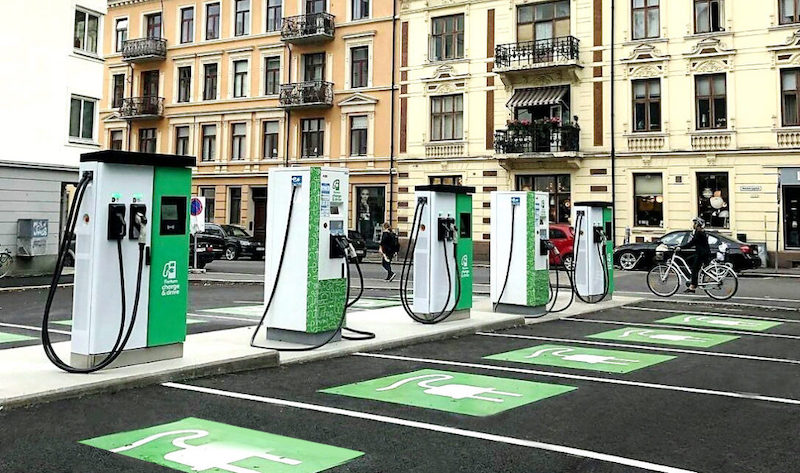
A future of wireless charging
They’ve also accomplished making Oslo the first city in the world to install wireless charging systems for electric taxis. The system consists of a number of charging plates installed on roadway sections used for the taxi queues.
The taxi driver only needs to stop its vehicle over one of the plates and the inductive charging system will take care of everything else automatically. Charged in small high-power increments of 6 to 8 minutes, the taxi should receive enough “juice” to drop off existing customers and take on new ones.

Oslo is also the first city in the world to feature an EV-only indoor parking garage with 86 type-2 chargers.
But retaining the incentives and keeping the charging infrastructure up to speed is only the tip of the iceberg when examining Oslo’s successful EV implementation model. Further measures such as a car-free city centre, low emission zones in greater Oslo, and congestion tax for ICE-powered vehicles are planned.
Furthermore, the Oslo city council is also planning on expanding the free-for-EVs residential parking zones and building more in-city toll gates in which zero-emission vehicles will be exempt.
Incentivising private companies to install chargers
The Oslo example tells us that EV adoption at record rates doesn’t come without issues of its own. Slow to answer to the growing demand for additional (and more modern) charging points, the Oslo city council had issued new incentives targeting private companies willing to help with the electrification process.
This has yielded considerable results as the number of charging points in Oslo grew from under 750 units back in 2015 to 1,450 stations in 2019. What’s more, a resolution has been passed to establish 600 new EV chargers in the near future.
Although Oslovians won’t have to stack in queues in order to charge their cars any more, they’ll have to start paying for the privilege from now on. As of 2019, charging in municipal parking spaces will cost NOK 10 per hour (a little over AUD $1.50 or USD $1), between 9 AM and 8 PM from Monday to Saturday.
Conclusion
We all know Norway is leading the race when it comes to electric vehicle adoption and some of the reasons behind their success have been discussed in this article.
However, the Norwegian EV adoption model could theoretically be implemented by any country – wealthy or poor – but as we established, there are some potential limitations in that regard. Every country willing to embark on a similar journey as Norway will face obstacles of its own; that’s for certain.
If Australia was to replicate at least a portion of Norway’s results, it will undoubtedly have to expand its EV charging infrastructure. The U.S. on the other hand, whose western seaboard is already prioritizing zero-emission vehicle expansion – especially in California – will still experience numerous challenges before inter-state EV travel becomes a less challenging endeavour.
Another point to consider is how autonomous vehicles will shape the future of transportation, there is no doubt that self-driving technologies will play a pivotal role in influencing how cities around the world will develop their transportation infrastructure.
Regardless of how long the EV revolution takes, the future of the automotive industry is looking bright, with electricity once again lighting the way.




